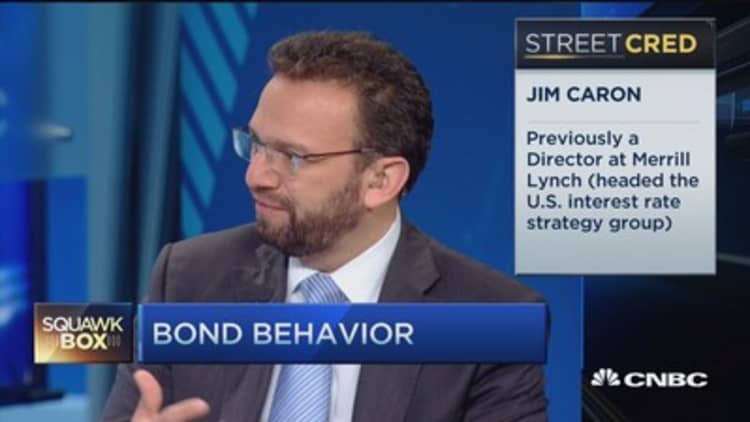
When it comes to interest rate policy, what the Federal Reserve says it will do at this week's meeting may diverge from its actions later this year, Morgan Stanley's Jim Caron said Tuesday.
The Fed is likely to keep a September rate hike on the table, Caron said, but Morgan Stanley believes the central bank will ultimately move only once this year, in December.
"I think the Fed will communicate that they're going to hike two times this year. Whether they do it or not is something that's going to be be more data dependent," the senior fixed income portfolio manager told CNBC's "Squawk Box."
Caron made his comments ahead of the start of a two-day monetary policy meeting of the central bank's Federal Open Market Committee, which is being held Tuesday and Wednesday. The Fed has kept interest rates near zero since December 2008, and is widely expected to begin raising its benchmark rate this year or early next year.
In a CNBC survey, Wall Street respondents indicated they believe the Fed would hike rates twice this year and four times next year.
Read More Wall Street sees Fed rate hike in 3Q: CNBC Fed survey
The Fed wants to maintain flexibility for 2015 and keep the median expectation for its federal funds rate at 0.625 percent, which would signal two rate hikes this year, Caron said.
However, Morgan Stanley is asking one question: Why the hurry?
"Yes, the data is getting better, but why not be absolutely certain that it's gotten better before they actually rush into a situation, which maybe they'd be sorry that they did," Caron said.
Investors must think about the pace of rate increases in terms of closing the output gap, the difference between the actual output of the economy and its potential output, he added. Morgan Stanley believes the 2015 GDP growth forecast from the Fed will likely be downgraded from a projection of about 2.5 percent in March to 2 percent.
"The key question is is that still fast enough growth to actually still close the output gap?" he said. "We think that potential growth is actually around 1.75 percent. Productivity is a lot slower. So even though 2 percent growth seems historically low, it's still fast enough to close the output gap."
The economy has reached "escape velocity" but it's still flying at a low altitude, Caron said. The Fed should allow the economy to climb before hiking rates, he added.
Scott Wren, senior global investment strategist at the Wells Fargo Investment Institute, said he expects Fed Chair Janet Yellen to indicate Wednesday that the central bank will begin raising rates in September. If she does not, traders can assume the rate rise has been pushed off past September, he added.
"Certainly the Fed's not going to make a move tomorrow, but if they're going to move in September, and that's what I think is likely to happen ... they're going to start hinting that that's going to happen," he told CNBC's "Squawk on the Street." "They are going to give the market two, three months of a heads-up."
The Fed needs to tell the market when it will raise rates, what the magnitude will be and how often it will raise rates, he said. "I think the market can digest that. They can deal with that. But the Fed needs to prep us."
Read MoreHere's how to profit if rates go nowhere: Trader
Wren sees the returning 10 percent to investors this year, despite the fact that the average is only up about 1.3 percent year to date. He said consensus for the first quarter was too low, and economic growth will outpace estimates for the rest of the year.
"We're going to see upside estimates move up, lots of earnings surprises," he said. "When you're at fair value, earnings have to pull the market higher."


